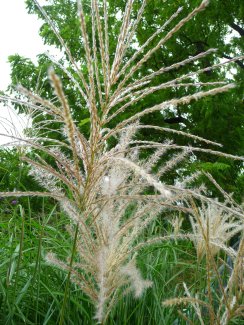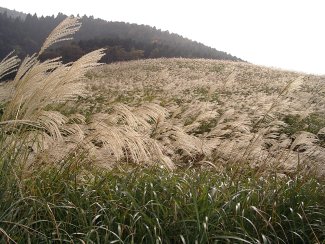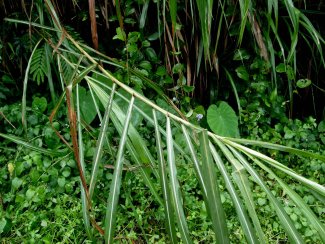Asia-Temperate. China: China - Anhui, - Fujian, - Gansu, - Guangdong, - Guangxi, - Guizhou, - Hainan, - Hebei, - Heilongjiang, - Henan, - Hubei, - Hunan, - Jiangsu, - Jiangxi, - Jilin, - Shaanxi, - Shandong, - Sichuan, - Yunnan, - Zhejiang; Hong Kong. Eastern Asia: Japan - Hokkaido, - Honshu, - Kyushu, - Shikoku; Korea; Taiwan. Russian Far East: Russian Federation - Kurile Islands, - Primorye, - Sakhalin. Asia-Tropical. Malesia: Indonesia - Celebes; Philippines. Is native to Southeast Asia where it occurs along roadsides and disturbed sites throughout much of Japan, especially at higher elevations (3,000-4,000 ft.).
It is a clump-forming grass with short, inconspicuous rhizomes and is adaptable to a variety of soil types including light, well-drained, nutrient-poor soils not suitable for agriculture such as roadsides, powerline rights-of-way, railroads, and steep embankments. It prefers full sun. Mature plants have slender, upright or somewhat arching leaves up to 18 in. long, with silvery midribs, sharp tips and rough margins and feathery, fan-shaped, terminal flower panicles that are silvery to pink in color and up to 2 ft. long. Flowering occurs September through October. More than fifty ornamental forms of Miscanthus sinensis are sold in the U.S. nursery trade. Most forms set little or no seed due to self-incompatibility, meaning that pollen from other forms is needed in order to produce viable seed. The species or wild type of Miscanthus likely originated from ornamental plantings. Due to the large number of forms planted, the wild type now produces a significant amount of viable seed that is wind-dispersed. It resembles ravenna-grass and other tall showy exotic ornamental grasses. Good substitutes would include eastern gamagrass (Tripsacum dactyloides), little bluestem (Schyzachirium scopyrium) and other native grasses. Removing seedheads is one way to reduce the likelihood of spread to new areas.
The species or wild type of Miscanthus likely originated from ornamental plantings. Due to the large number of forms planted, the wild type now produces a significant amount of viable seed that is wind-dispersed. It resembles ravenna-grass and other tall showy exotic ornamental grasses. Good substitutes would include eastern gamagrass (Tripsacum dactyloides), little bluestem (Schyzachirium scopyrium) and other native grasses. Removing seedheads is one way to reduce the likelihood of spread to new areas. It is popular and frequently planted in commercial and residential landscapes. Japanese silvergrass is found in scattered locations in most of the eastern U.S. and as far west as Missouri and Louisiana, and in California and Colorado. The earliest known introduction of M. sinensis to the United States was from Japan to Asheville, NC in 1893 and later to Washington, DC in 1894. In 1907 the Biltmore Nursery in Asheville, NC had at least four varieties available for sale via mail
order catalog , and by 1913 M. sinensis had naturalized in New York, Florida, and Washington, DC. Miscanthus sinensis had ‘‘become thoroughly established in many places’’ in West Virginia as early as the 1940s. Despite escapes, the ornamental grass industry has boomed in the last 20 yr, largely because of their pleasing aesthetic and low input costs. Liberty Hyde Bailey wrote about Miscanthus sinensis (Eulalia japonica Trin.) that, ‘‘Although many progressive nurserymen now advertise these favorite grasses as Miscanthus, the name Eulalia will probably remain in the English language as a thoroughly naturalized word, like Geranium or Chrysanthemum.’’ In a search for the origins of Eulalia japonica in the United States, it was found that the Trade List of Plants for the Spring of 1878, the catalogue of the John Dick, Helendale Nursery, Philadelphia, PA, offered Eulalia japonica variegata for 25 to 50 cents each. The same nursery also offered Eulalia japonica zebrina in their Fall 1879 catalogue for 25 to 75 cents each. As a result of multiple introductions from Asia, traditional breeding programs, and commercialization, there are now over 100 named cultivars of M. sinensis available on the market. Miscanthus sinensis has become one of the most popular and highly recommended ornamental grasses in the United States. As recently as 2008, sales of M. sinensis totaled nearly $40 million in the state of North Carolina alone. Currently, M. sinensis has naturalized in at least 25 states, and
its known distribution continues to expand as more populations are added to public databases. Of the 25 states with naturalized populations, 21 are east of the
Mississippi River; however, occurrences have also been recorded in western states such as California and Colorado.


